This post is in partnership with 3-IN-ONE® Brand. All thoughts and words are my own.
If it looks like your gardening tools have seen better days, don’t be embarrassed—dirty tools are a sign of hard work and plentiful rewards.
But they shouldn’t be put away dirty.
I know, I know—who wants to clean tools every single time if all you’re doing is snipping a few stems here and there?
Believe me when I say I’m one of the laziest gardeners there is. I let weeds get unruly and my end-of-season garden clean-up is usually a few weeks too late. But the one thing I always stay on top of is keeping my garden tools clean and sharp—and it takes mere minutes.
The trick is making a DIY tool cleaning station that takes the chore out of maintaining your tools. It’s quick and simple to set up for the first time, and just as quick and simple to clean your tools once you get it going.
This tool cleaning station not only keeps your tools grime-free and rust-free, it sharpens them gently (and automatically, with no extra effort on your part) so you can dig, cut, trim, and prune your plants safely and effectively.
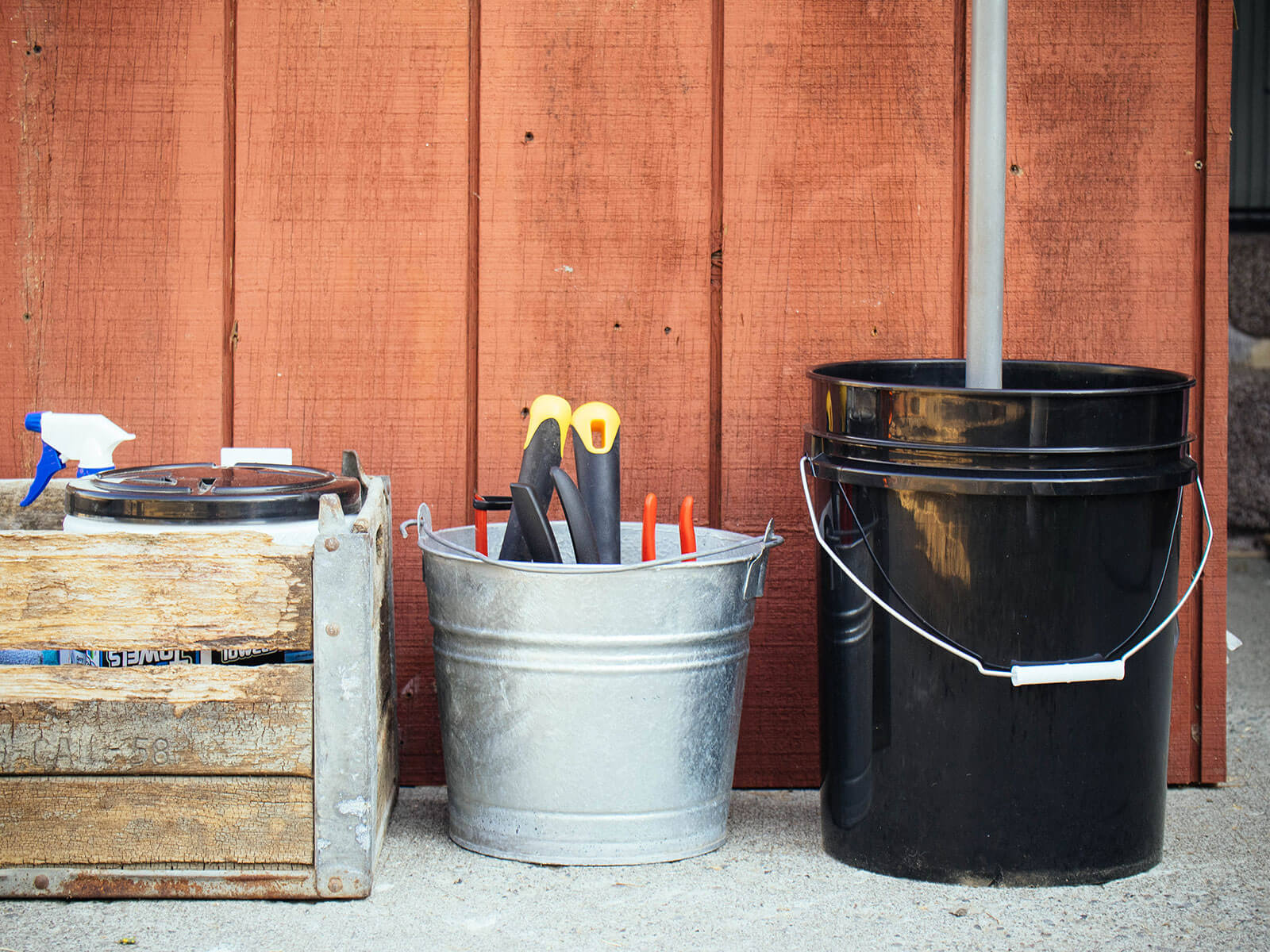
The best way to clean garden tools
You might not need to follow every step every time, but you’ll want to tackle issues like sap and rust before they become bigger problems down the line.
Related: The Best Way to Remove Rust From Rools—No Scrubbing Required
Gather all of your supplies in a bin and place it next to your “quick clean” bucket in a sheltered spot near your garden (like a shed, garage, mudroom, or covered walkway).
The key is keeping them where they’re convenient to grab on your way out to the yard, and easy to put away as you’re coming back in the house.
It’s just too easy to fall in the habit of dumping your tools in random places (thereby misplacing them or forgetting to clean them), or storing them wherever you have room (which could mean an out-of-the-way corner in your yard or a shelf that requires a stepladder to reach).
For the duration of the gardening season, at least, clear a small space for your tool cleaning station and make it easily accessible when you’re working outside. (Mine is just against the wall of a covered tool storage area.)

What you’ll need for the storage bin
- Small storage bin, crate, or pail
- Putty knife or plastic scraper
- Shop towels or rags
- 3-IN-ONE® Multi-Purpose Oil
- Steel wool
- Boiled linseed oil, pure tung oil, or teak oil
- 70% isopropyl alcohol (rubbing alcohol)
What you’ll need for the “quick clean” bucket
- Sturdy bucket (at least 8 inches deep and 12 inches across, depending on how many hand tools you have)
- 5-gallon bucket (optional, for large tool cleaning station)
- Sand (see Note below)
Note: The sand you use can be as fine as all-purpose play sand, or as coarse as washed plaster sand. Just make sure you source clean sand from a home improvement center or landscaping company.
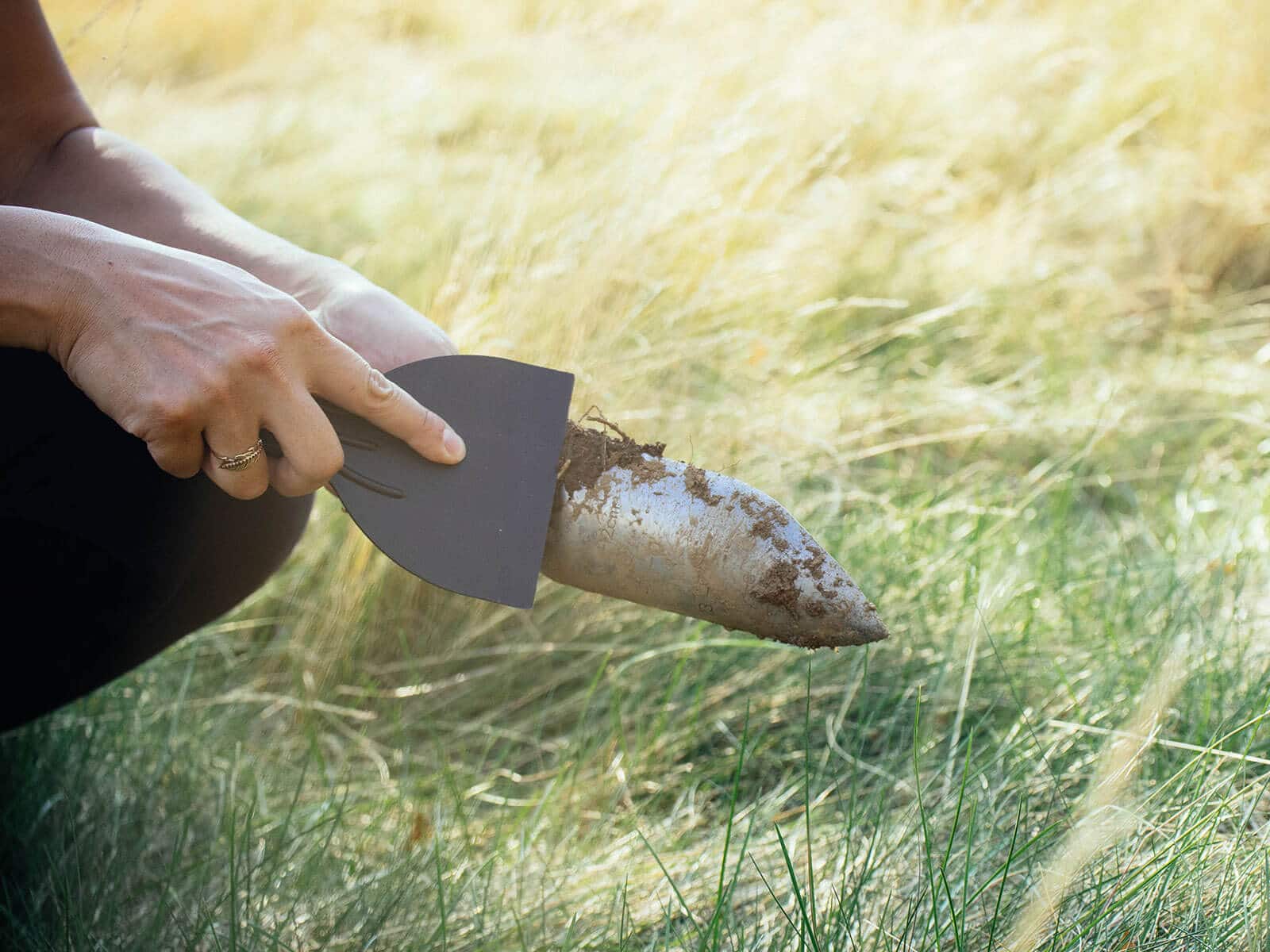
Step 1: Remove caked-on dirt.
Scrape off any stubborn, caked-on dirt with a putty knife, then wash off any remaining dirt with a sharp blast of water from a garden hose.
Dry your tools thoroughly with a towel. (Don’t let them air dry, as they could start to rust before all the moisture evaporates.)
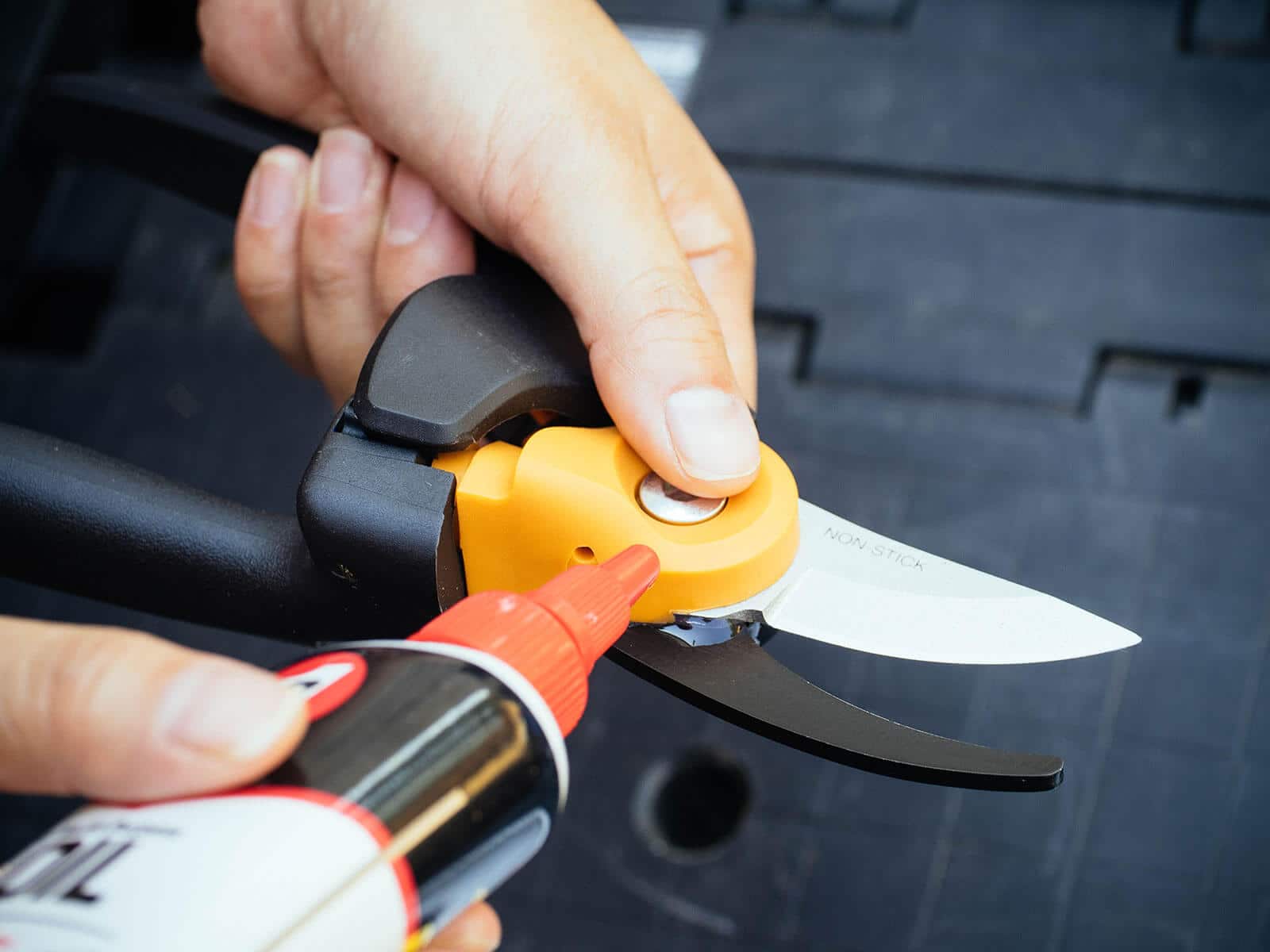
Step 2: Remove sap.
If your gardening shears or clippers feel sticky, you might have sap, resin, or insect residue.
Apply a few drops of 3-IN-ONE Multi-Purpose Oil to the sticky spots and wipe with a clean rag. Pay special attention to hinged areas and pivot joints that tend to get gummed up.

Step 3: Penetrate rust.
If you see rust or pitting on your gardening tools—especially if it’s causing moving parts to stick—squirt a few drops of 3-IN-ONE Multi-Purpose Oil on those areas and give a good scrub with steel wool. Wipe off the residue with a rag and repeat as needed.
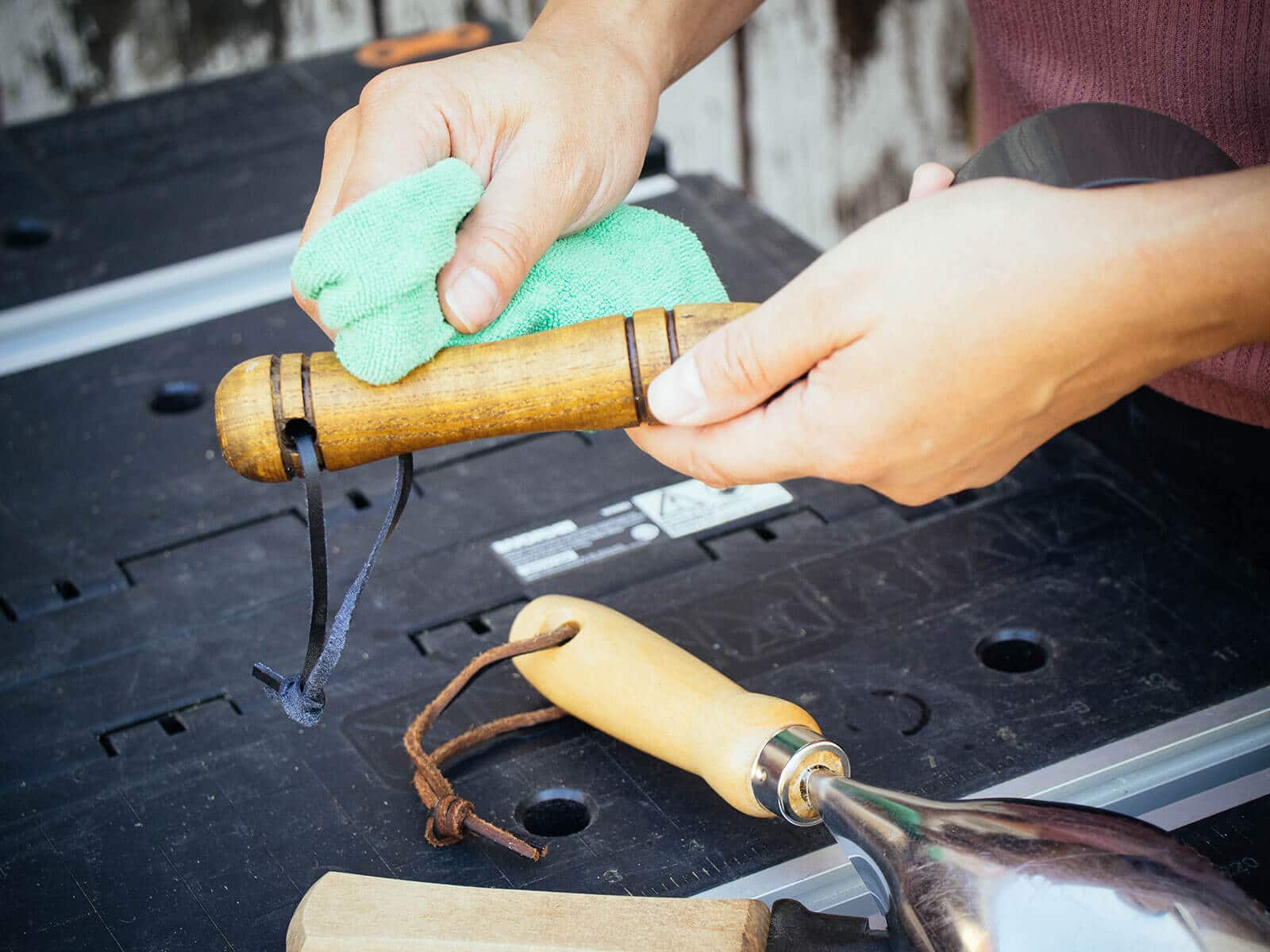
Step 4: Oil the wooden handles.
Unpainted wooden handles dry out easily, especially if your tools have been sitting outside all season.
Saturate a rag with boiled linseed oil and rub it a few times over your wooden handles. Allow the oil to penetrate for about 10 minutes, then buff the handles briskly with a clean rag until they feel dry.
If the handles are extra dry (perhaps from baking in the sun the past couple of summers), they might need quite a bit of oil. Let the wood soak up the oil overnight, then apply more oil as needed the next day.
Related: Homemade Spoon Oil (Or As I Like to Call It, Spoon Butta!)
Safety tip: Lay the oily rag flat to air dry between uses. (You can also hang it up near your tools to remind yourself to oil the handles periodically.) Never pile oily rags together or dump them in the trash while wet. Oil-soaked rags release heat as they dry and can ignite on their own, especially on a hot day.
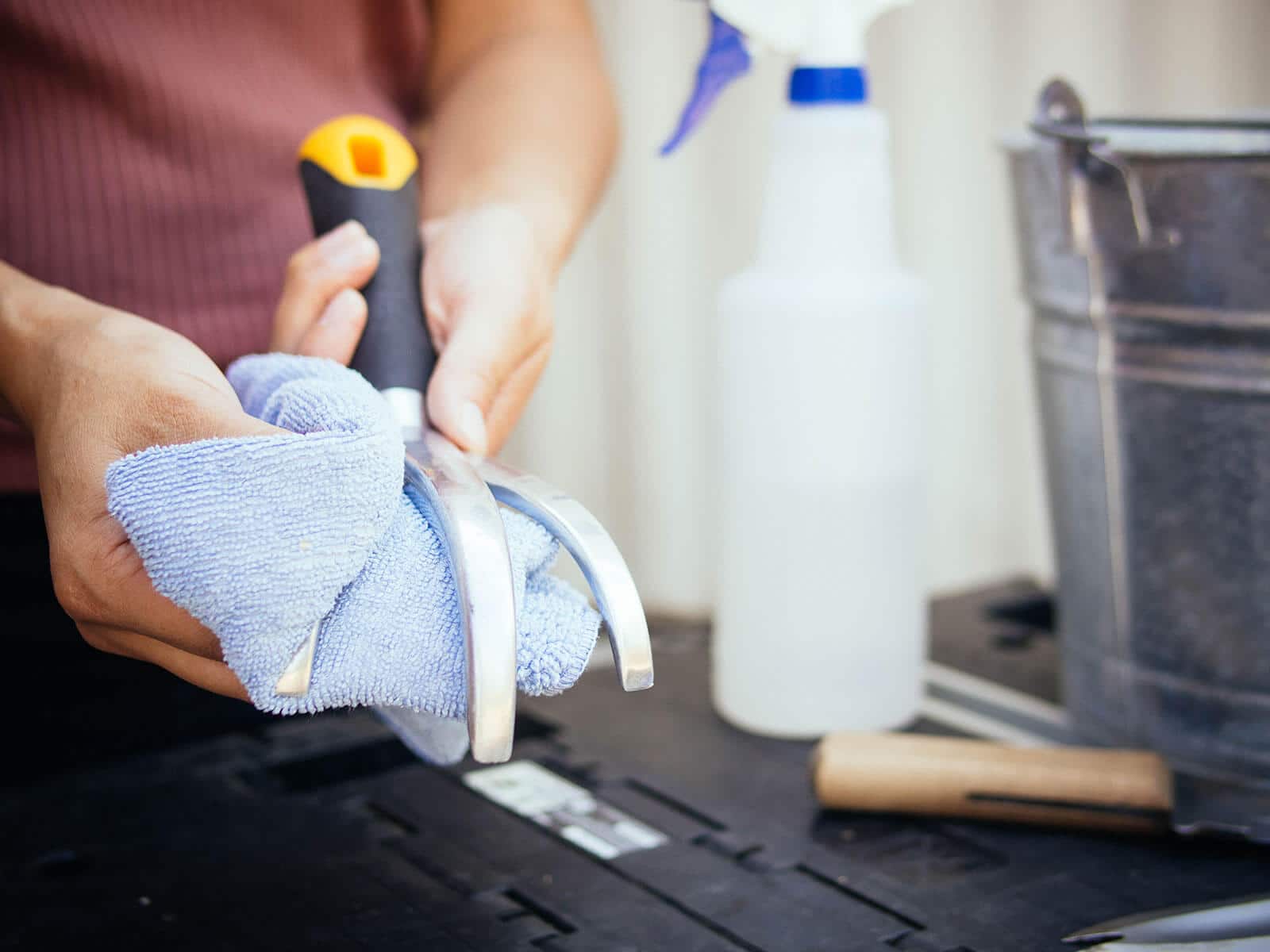
Step 5: Disinfect blades and tines.
Pruners and other tools that were used on diseased plants should be disinfected so they don’t spread fungi and bacteria to healthy plants.
You can safely sterilize your tools with rubbing alcohol, and I like to keep mine in a spray bottle for ease of use.
Spray all sides of the blades, tines, hinges, and pivot joints, then wipe them down. Or, dab a small amount of rubbing alcohol onto a clean rag to sanitize your tools after use.
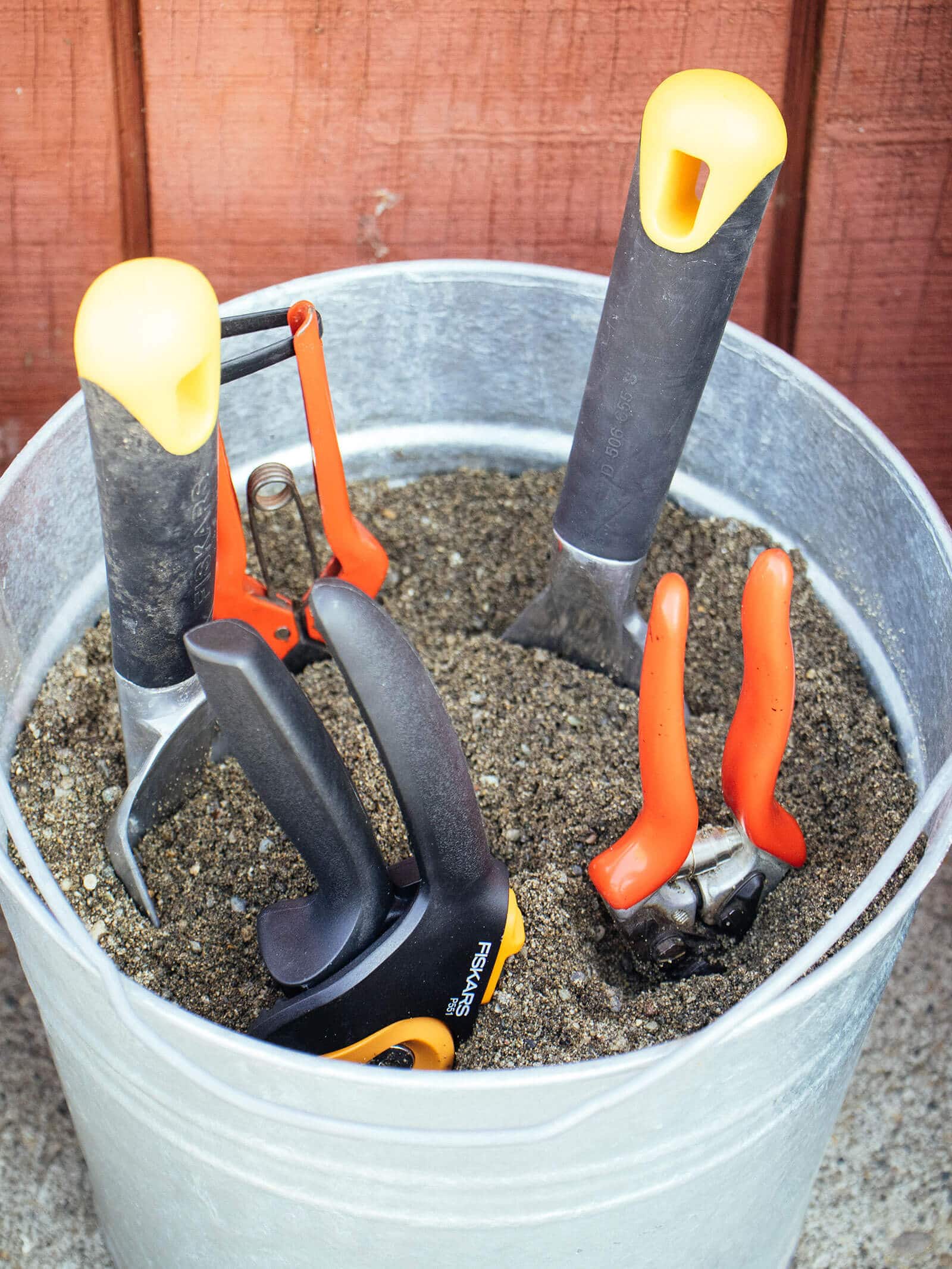
Step 6: Store tools in a “quick clean” bucket.
To set up your “quick clean” bucket, fill a bucket about three-quarters full with sand. Mix in just enough 3-IN-ONE Multi-Purpose Oil to achieve a damp (but not soaking wet) consistency—similar to a wrung-out sponge.
After a day in the garden, deposit your hand tools in the “quick clean” bucket to protect their finish and keep them free of rust.
You can also make a second “quick clean” bucket (using a deeper 5-gallon bucket) to clean and sharpen shovels, spades, and garden hoes before storing them in your shed or garage. Having this thin coat of oil on your tools protects them against corrosion, especially if you live in a humid or foggy climate.
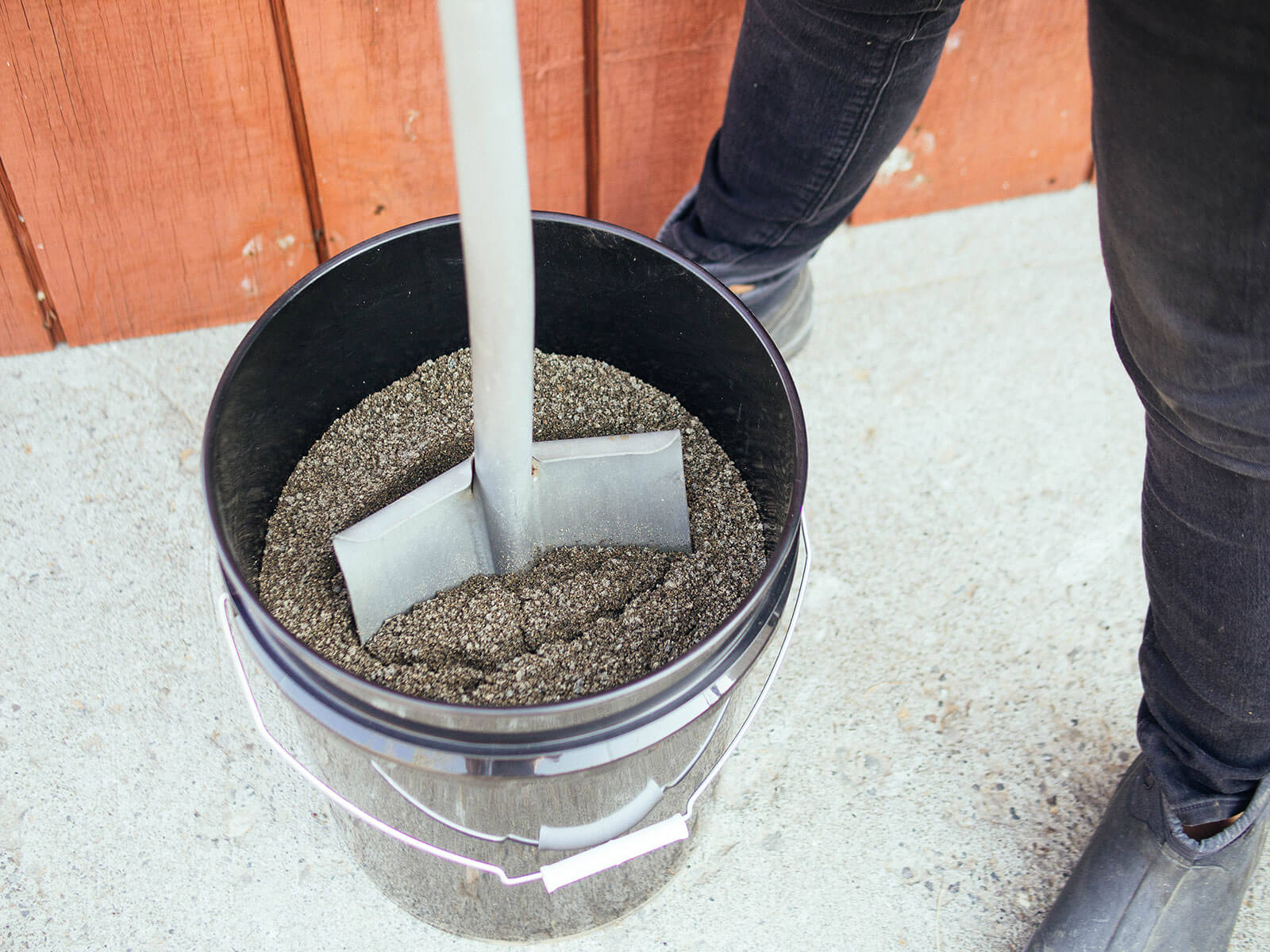
Common questions about cleaning garden tools
I can only find linseed oil in the store, not boiled linseed oil. Can I use that instead for oiling my wooden handles?
Both types of linseed oil will work, but boiled linseed oil dries faster (in two or three days, versus two weeks for raw linseed oil).
If you’re done with your tools for the season, go ahead and use whichever type of linseed oil is readily available. In a pinch, you can also use flaxseed oil (from the supermarket), which is simply food-grade linseed oil.
Can you use olive oil to oil wooden handles?
I don’t recommend using olive oil or vegetable oil to treat your garden tool handles. Non-drying oils like these can turn sticky or rancid over time.
Can you use disinfectant wipes to sanitize your gardening tools?
Household disinfectant wipes (like Lysol or Clorox) can be used to sanitize garden tools, but their effectiveness against plant pathogens hasn’t been scientifically determined.
They’re also a little more expensive than rubbing alcohol (my first choice for garden disinfection) and after opening, the wipes tend to dry out if they aren’t used frequently.
My gardening tools are all stainless steel. Do I still need to oil them?
Stainless steel doesn’t necessarily mean free of stains—it simply means the metal stains less than carbon or alloy steels. And certain grades of stainless steel are more prone to corrosion than others, so your stainless steel tool could start to rust if not properly cared for.
Applying a thin layer of oil like 3-IN-ONE Multi-Purpose Oil to all your tools (including stainless steel tools) is easy insurance against rusting (and lots of elbow grease later on).
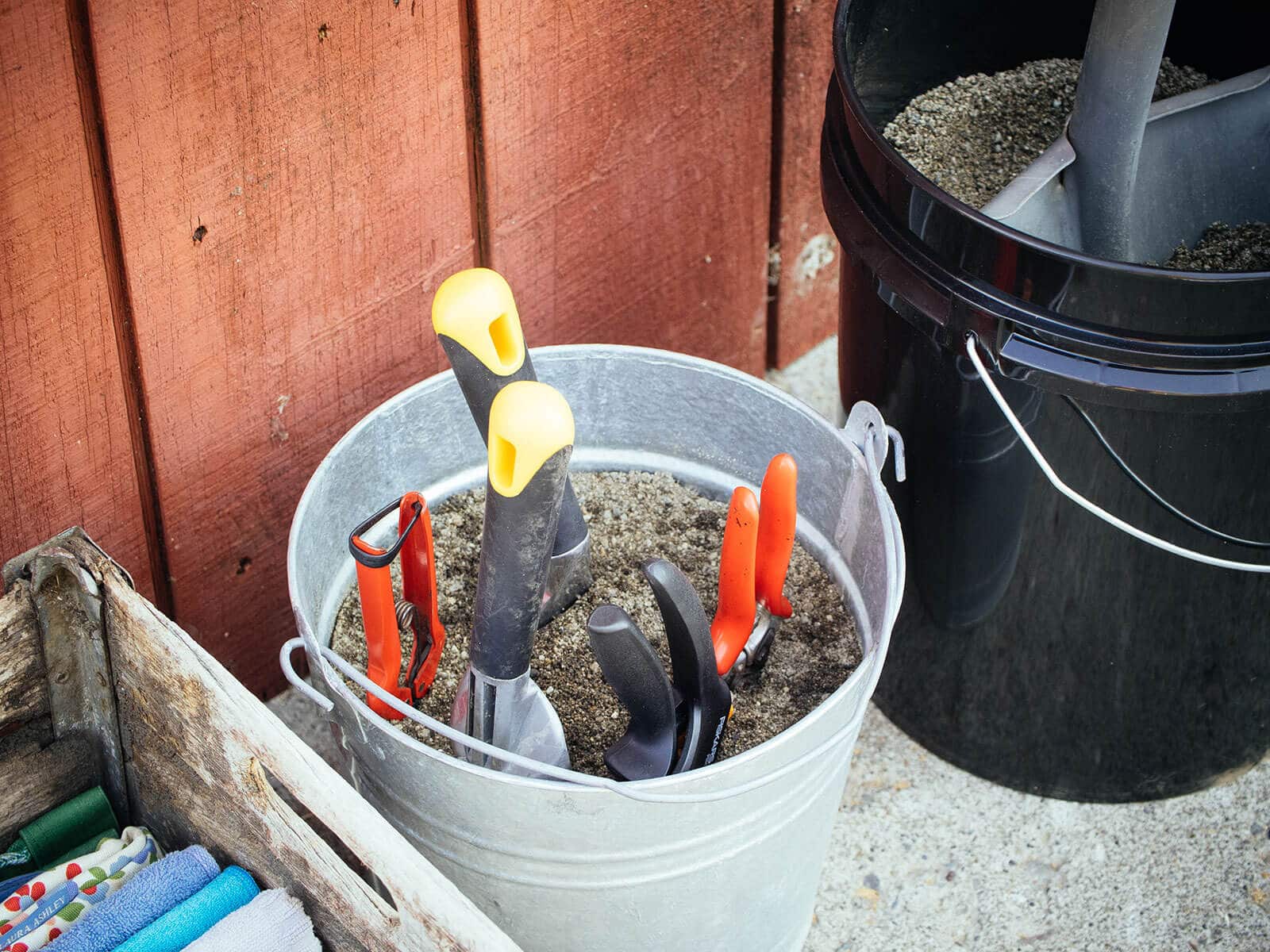
Recommended tool cleaning supplies:
[show_shopthepost_widget id=”4162455″]
Crates and Pallet Large Wood Crate | Jezero Multi-Purpose Milk Crate | CleverMade Collapsible Storage Bins | Kapoua Putty Knife | Zep Industrial Towels | Simpli-Magic Shop Towels | 3-IN-ONE Multi-Purpose Oil | Rhodes American Coarse Steel Wool | Sunnyside Corporation Boiled Linseed Oil | All Clean Co. 70% Isopropyl Alcohol | Behrens Galvanized Steel Utility Pail | Argee 5-Gallon Bucket
This post is sponsored by 3-IN-ONE® Brand.
You can find 3-IN-ONE® Multi-Purpose Oil at Walmart and other retailers.
Follow 3-IN-ONE® Brand on Facebook and Instagram for more gardening tools and maintenance tips!
View the Web Story on DIY tool cleaning station.


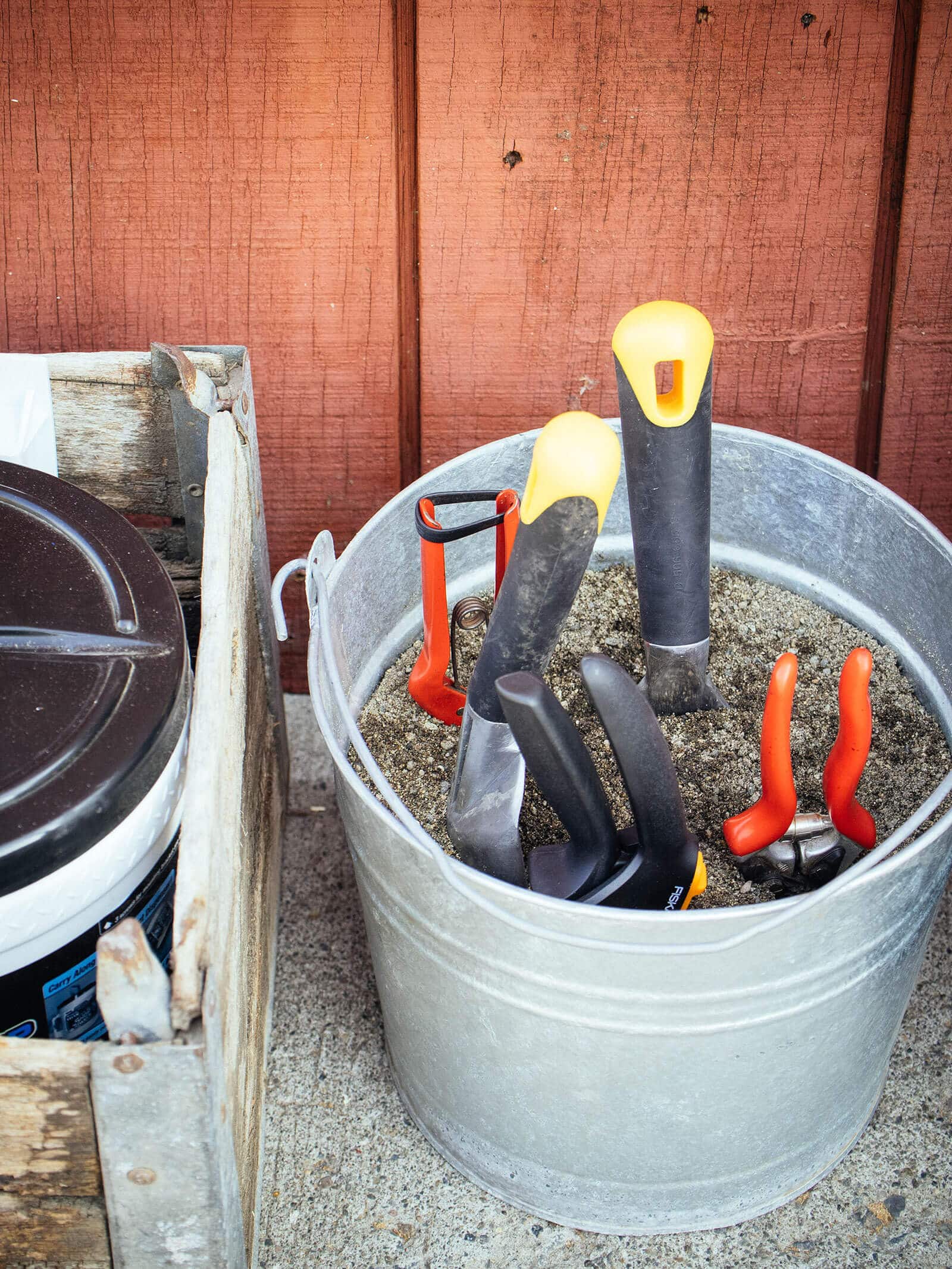













For Years, I had my interns wipe down tools after use with used crankcase oil obtained during an oil change. What do you think of this choice?
Can I use a plastic bucket for cleaning my tools?Is Can WD 40 be used to oil the tools?
This is one of my favorite posts, and I do love your blog. We’ve been using this station for a year now and find it very useful and are just heading out to refresh and sharpen tools. Thanks for your blog!
That is awesome. 65 and never knew about this.
Hi there! Is the sand bad for the pruners? I created the quick clean bucket and I hear sand in the moving mechanism everytime I open and close the pruners.
Whitney,
How much oil is required in each of the buckets. It seems as if it is sold in 4 oz. containers how many would be required?
Whitney,
HOW MUCH OIL IS REQUIRED FOR EACH SIZE BUCKET, IT SEEMS AS IF THE 3 IN ONE IS SOLD IN 4OZ. SIZES. HOW MANY WOULD BE NECESSARY.